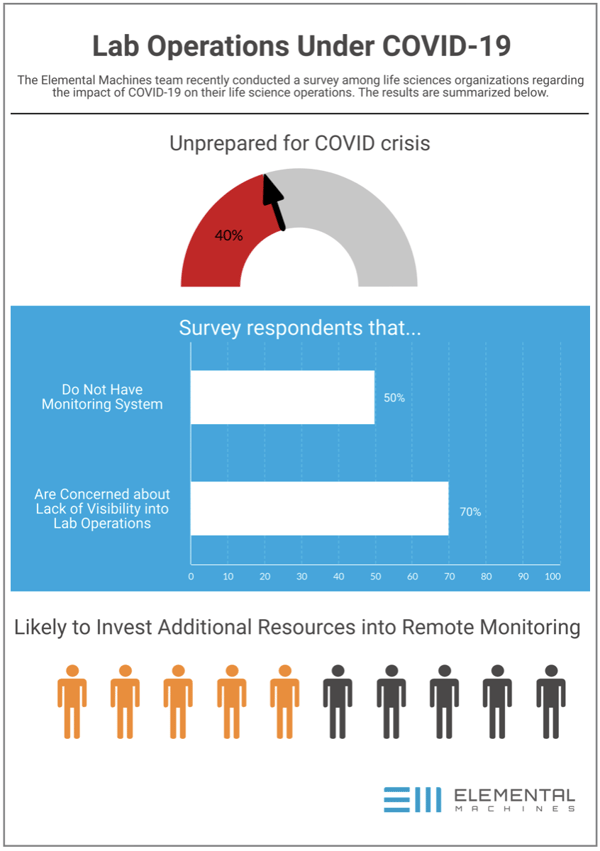Avoiding a COVID related crisis in your Laboratory

Several states are approaching or have approached peak numbers for COVID-19 cases, but we are far from getting back to normal and expect social distancing to continue for some time. And that means working from home will continue as well. We surveyed lab and operations managers, scientists, and QA/RA personnel in the life sciences industry to learn how they are coping with this new working arrangement. The results are summarized in Figure 1 below.
Many life sciences organizations are operating with no staff or skeletal staff onsite to perform essential functions only. Facilities that are not working on COVID-related treatments will likely remain empty. This poses issues because even when scientists pause their work, R&D laboratories still need to be monitored as specialized equipment is used to house precious (read: expensive) materials slated to be used in future studies. Maintaining the integrity of these materials is paramount so that scientists can dive right in when they are back in the lab.
Figure 1: Survey results of Lab Operations in the time of COVID
Needless to say, all of our survey respondents indicated that the current circumstances have disrupted their company operations. Over 40% of survey respondents reported that they felt underprepared in managing the current COVID related crisis. To compound complications, recent tornadoes in the South left businesses without power, while high wind gusts in the Northeast damaged power lines leaving many businesses (and homes) without power. Thus, it comes as no surprise that nearly 70% of survey respondents are concerned about lack of visibility into their workspace.
We learned that about 50% of survey respondents do not have ANY platform to monitor facilities in the event of power outages or network outages, yet 70% of respondents are concerned about the lack of visibility into their laboratories, meaning that some organizations that do have a system in place still have reservations about their solution. And since 50% of respondents are considering making additional investments in remote monitoring solutions, we thought we'd share some important features to look out for. The ideal monitoring solution should meet these four criteria:
- Reliable- A lab monitoring solution should be able to operate even in the event of power and network outages. This can be achieved with a system equipped with battery and cellular backup.
- Data accessibility - Data collected through the platform should allow for easy transfer via API into ELN or LIMS systems.
- User friendly - Get email and SMS alerts when conditions in your lab deviate from your specified norm. See Figure 2 below for details. Clean, organized layout on a cloud-based dashboard to get the info you need anytime, anywhere.
- Flexibility- For long term consideration - ease of scalability for lab expansion and ease of installation for lab relocation are key. It's better to avoid drilling holes in your equipment or lab. A battery-power system can be up and running in under a minute.

Figure 2: Real-time alerts when conditions deviate from your specified range
We’re far from returning back to normal just yet, so if you lack confidence in your current lab monitoring solution, now is the time to explore new options and avert the potential loss of time- and cost-intensive materials stored in your laboratory. Our survey revealed that losing valuable material is more common than you think - 70% of respondents have experienced material loss due to equipment malfunction or failure. Some voiced concern over maintaining appropriate conditions for cell cultures, while others worried about monitoring cryogenic tanks and gas levels. And even when our COVID worries are over, we still have ‘normal’ circumstances to deal with - hurricanes, tornadoes, earthquakes, and snowstorms, depending on where you live.
In keeping with our mission of Accelerating Science, we are providing life sciences organizations FREE MONITORING to help maintain their lab operations and avert potential issues. Contact us using the link below to learn more about our program.
Never miss a beat...
Subscribe to our bi-monthly EM Connect Newsletter to stay up-to-date on all things LabOps, biotech, and more!
